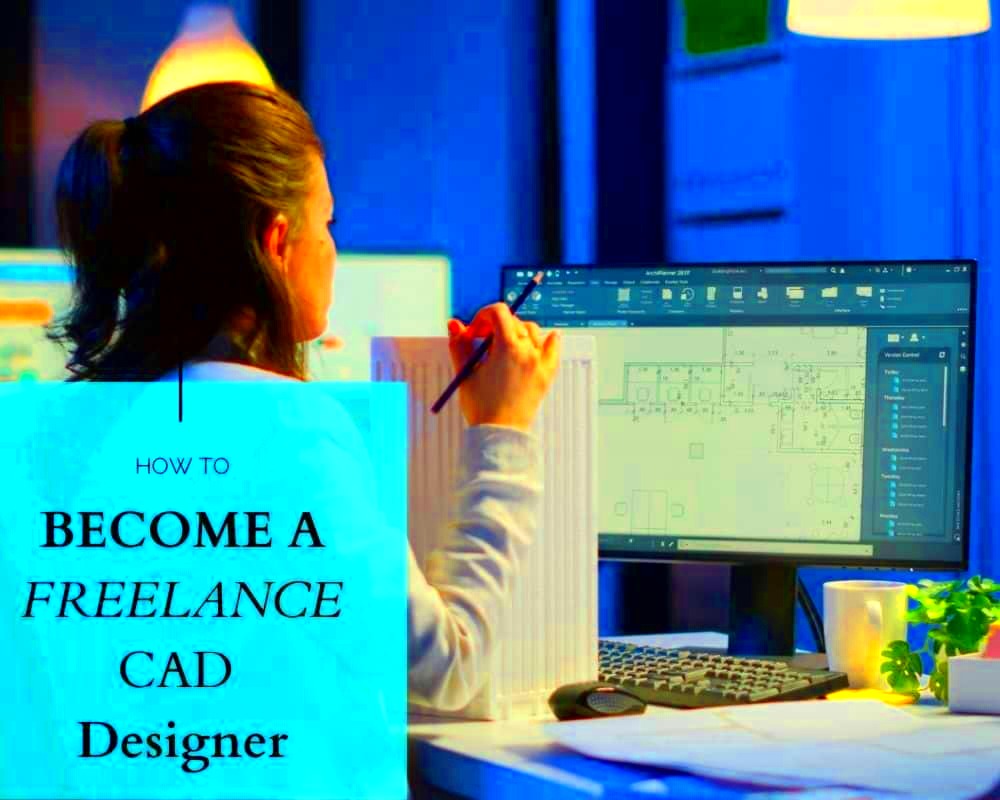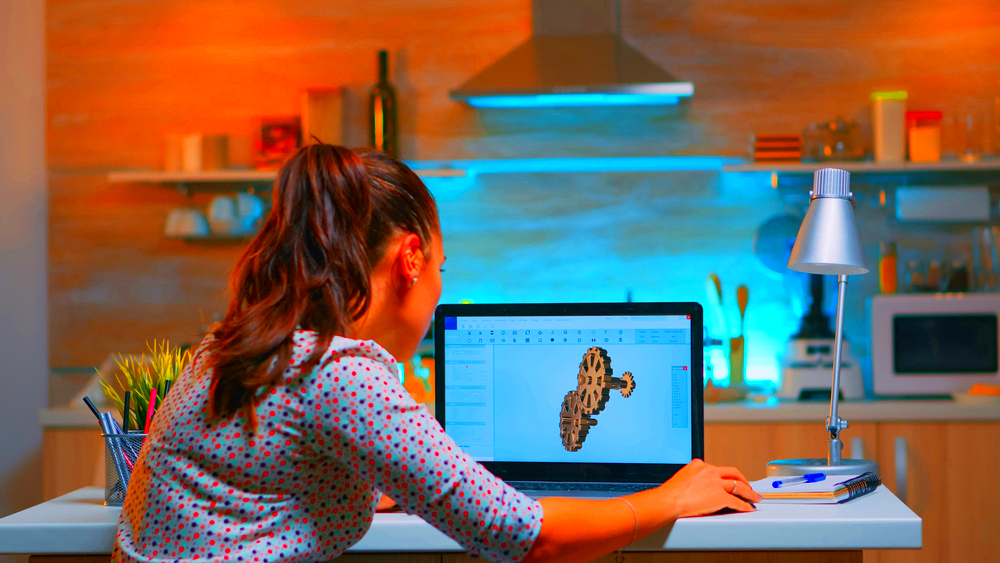Freelance CAD design is an exciting career that allows you to use your creativity and technical skills to create detailed designs for clients. As a freelance CAD designer, you can work with various industries like architecture, engineering, product design, and manufacturing. One of the main benefits is the freedom to choose your clients, set your own schedule, and work from anywhere. However, it also comes with challenges such as finding clients, managing your time, and ensuring a steady income. Whether you're just starting out or looking to grow your freelance business, there are key factors that will help you succeed in this field.
Understanding the Role of a Freelance CAD Designer

As a freelance CAD designer, your role involves creating detailed 2D or 3D models using computer-aided design (CAD) software. These models are typically used in industries such as architecture, engineering, and manufacturing. You may be asked to design anything from building plans to mechanical parts, depending on your niche.
Your responsibilities as a freelancer can vary widely but often include:
- Meeting with clients to understand their design needs.
- Creating and refining designs using CAD software.
- Ensuring designs meet industry standards and regulations.
- Communicating with clients throughout the project to ensure satisfaction.
- Making adjustments to designs based on client feedback.
Since you’re working independently, you must also manage other aspects of your business, such as marketing, invoicing, and client relationships. Freelance CAD designers often enjoy more flexibility in their work, but it requires a strong sense of discipline and organization to succeed.
Also Read This: How to Change Your Rating on Fiverr: A Step-by-Step Guide
Skills Required for Success in CAD Design

To succeed as a freelance CAD designer, you need a combination of technical skills, creativity, and business acumen. Here are the most important skills you should focus on:
- Proficiency in CAD Software: Whether it's AutoCAD, SolidWorks, or SketchUp, you need to be highly skilled in using CAD tools. Most designers specialize in specific software, so becoming an expert in one or two tools is crucial.
- Attention to Detail: CAD design is all about precision. Small errors can lead to big problems later in the process, so it's important to be meticulous in your designs.
- Problem-Solving: You'll often face design challenges that require creative solutions. Strong problem-solving skills are essential to overcoming obstacles and delivering high-quality designs.
- Communication Skills: Since you'll be working with clients, clear communication is key. You must understand their needs, explain your designs, and negotiate terms effectively.
- Time Management: As a freelancer, you have to juggle multiple projects at once. Being able to manage your time efficiently and meet deadlines is critical for long-term success.
Investing in these skills will help you stand out in the competitive freelance market and position yourself as a reliable and talented CAD designer.
Also Read This: When Do I Get Paid from Fiverr?
How to Build a Strong Portfolio as a Freelance CAD Designer

A strong portfolio is essential for showcasing your skills and attracting potential clients. As a freelance CAD designer, your portfolio is your primary tool for demonstrating the quality and versatility of your work. It should highlight your best projects and provide an overview of the services you offer. Here are some tips on how to build a portfolio that stands out:
- Showcase a Variety of Projects: Include different types of designs to demonstrate your range. This could include architectural drawings, mechanical parts, product prototypes, or 3D models. Showing versatility will help you appeal to a broader range of clients.
- Highlight Your Best Work: Only showcase your best projects. Quality is more important than quantity. Ensure each piece represents your highest level of skill and attention to detail.
- Include Client Testimonials: If possible, add testimonials from previous clients. Positive feedback adds credibility and shows that you're reliable and easy to work with.
- Use Professional Visuals: High-quality images of your designs are important. Ensure they are clear and well-lit. If possible, include before-and-after shots or renders to show the transformation your work achieved.
- Organize Your Portfolio Effectively: Categorize your projects by type, industry, or design tool used. This makes it easy for potential clients to navigate your work and find examples that fit their needs.
Building a portfolio takes time, but it’s an investment that will pay off as you continue to build your freelance career. Always update your portfolio with new work to keep it fresh and relevant.
Also Read This: How to Be Successful in Fiverr
Setting Your Rates and Managing Finances
As a freelance CAD designer, one of the most challenging aspects of the job is setting your rates and managing your finances. Unlike salaried employees, you have the flexibility to choose your pricing structure, but it’s important to find a balance between staying competitive and ensuring you’re paid fairly for your skills. Here are some tips to help you set your rates and manage your finances effectively:
- Research Industry Rates: Before setting your rates, research what other CAD designers are charging in your niche and location. This will give you a benchmark to help you price your services competitively.
- Consider Your Experience: Your rates should reflect your level of experience. If you're just starting out, you may need to charge lower rates to attract clients, but as you gain experience and build your portfolio, you can gradually increase your rates.
- Offer Different Pricing Models: Some clients prefer hourly rates, while others may prefer a fixed price for a specific project. Offering different pricing options can help you appeal to a wider variety of clients.
- Track Your Expenses: As a freelancer, you’ll need to track your income and expenses to ensure you’re making a profit. Use accounting tools to help you manage your finances and set aside money for taxes.
- Save for Taxes and Retirement: Freelancers are responsible for their own taxes, so it’s important to set aside a percentage of your income for tax payments. It’s also a good idea to contribute to a retirement fund to ensure financial security in the future.
By understanding the financial aspects of freelancing and pricing your services fairly, you can set yourself up for a successful and sustainable freelance career.
Also Read This: Why I Am Unable to Join Fiverr
How to Market Yourself as a Freelance CAD Designer
Marketing yourself as a freelance CAD designer is crucial for attracting clients and growing your business. Since you don’t have the backing of a company, it’s important to build your personal brand and effectively communicate your skills to potential clients. Here are some strategies you can use to market yourself:
- Create a Professional Website: A website is a great way to showcase your portfolio, list your services, and provide contact information. Having an online presence makes it easier for potential clients to find you and learn more about your work.
- Use Social Media: Platforms like LinkedIn, Instagram, and Twitter can help you connect with potential clients and other professionals in your industry. Share your work regularly and engage with your audience to build your online presence.
- Network with Other Professionals: Networking is key to gaining new clients. Attend industry events, join online forums, or reach out to professionals in related fields, such as architects or engineers, who may need your services.
- Offer Free Resources or Tutorials: Sharing your expertise through blog posts or tutorials can help establish you as an authority in your field. Offering free value also encourages people to trust you and consider hiring you for paid work.
- Leverage Freelance Platforms: Websites like Fiverr, Upwork, and Freelancer are excellent platforms for finding clients. Create a strong profile, showcase your portfolio, and respond to job postings to increase your chances of landing projects.
Marketing yourself as a freelance CAD designer requires time and effort, but with consistent work and a strong personal brand, you can attract high-quality clients and grow your business.
Also Read This: How Much to Charge for a PowerPoint Presentation on Fiverr?
Managing Client Expectations and Communication
Managing client expectations is a key part of a successful freelance career. Clear communication and setting realistic goals from the start can help avoid misunderstandings and ensure that both you and your clients are happy with the final result. Here are some tips for managing client expectations effectively:
- Clarify Project Scope Early On: Before starting a project, have a detailed conversation with your client about what is expected. Define the scope of the project, including deadlines, deliverables, and specific requirements. This will help avoid scope creep and ensure that both parties are aligned.
- Set Realistic Deadlines: Always be honest about how long a project will take. Don’t overpromise or underdeliver. If a project will take a week, let the client know. It’s better to set a realistic deadline and exceed expectations than to promise something you can’t deliver.
- Maintain Regular Communication: Keep your client updated throughout the project. Send progress reports or updates to let them know how things are going. This shows professionalism and helps clients feel involved in the process.
- Be Open to Feedback: Clients may request changes during the project. Be open to constructive criticism and handle it professionally. Ensure that you understand their feedback clearly before making revisions.
- Address Issues Promptly: If problems arise, address them as soon as possible. Whether it’s a technical issue or a miscommunication, tackling problems early can prevent them from growing into bigger issues later.
By managing expectations and maintaining strong communication, you can build lasting relationships with clients and ensure the success of your freelance career.
Also Read This: How to Earn from Fiverr Affiliate in 2023
Frequently Asked Questions
As a freelance CAD designer, you might have a lot of questions, especially if you’re just starting out. Here are some common questions and answers that can help guide you:
- How do I find clients? There are many ways to find clients, including using freelance platforms like Fiverr and Upwork, networking with other professionals, or marketing your services on social media. Building a strong portfolio and asking for referrals from satisfied clients can also help you gain new business.
- What should I charge for my services? Rates can vary based on your experience, the complexity of the project, and your location. Research industry standards and set your rates accordingly. As you gain more experience and build your portfolio, you can gradually increase your rates.
- How do I handle client revisions? Revisions are a normal part of the design process. Be clear with your clients about how many revisions are included in your pricing and what constitutes an additional charge. Always ensure that you understand the revision request before proceeding.
- Do I need a contract? Yes, it’s always a good idea to have a contract in place. A contract outlines the terms of the project, including payment terms, deadlines, and the scope of work. It helps protect both you and your client from misunderstandings.
- How do I stay motivated as a freelancer? Staying motivated as a freelancer can be tough, but setting clear goals, establishing a daily routine, and celebrating small wins can help keep you on track. It’s also important to find a balance between work and personal time to avoid burnout.
Conclusion: Steps to Success as a Freelance CAD Designer
Becoming a successful freelance CAD designer takes time, dedication, and continuous learning. But with the right approach, it’s a rewarding career that offers flexibility and opportunities for growth. Here are the key steps to set yourself up for success:
- Build Your Skills: Always strive to improve your skills and stay updated with the latest software and design trends. The more skilled you are, the more valuable you’ll be to clients.
- Create a Strong Portfolio: Your portfolio is your best marketing tool. Make sure it showcases your best work and reflects your expertise. Update it regularly with new projects.
- Network and Market Yourself: Use social media, freelance platforms, and networking events to connect with potential clients. Don’t rely solely on one source of business.
- Set Realistic Expectations: Be clear about deadlines, pricing, and project scope. Effective communication will help you manage client expectations and prevent conflicts.
- Manage Your Finances Wisely: Track your income and expenses, set aside money for taxes, and make sure you’re charging what you’re worth. Financial management is key to sustaining your freelance career.
By following these steps and remaining dedicated to your craft, you can build a successful freelance CAD design business that’s both fulfilling and financially rewarding.




